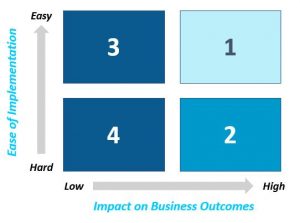By Sue Iannone
Let’s start this article by establishing one fact up front: That old cliché about how we all should “do more with less” is bogus. Perhaps not it all cases, but it’s definitely bogus when it comes to leading a Learning and Development (L&D) organization in a biopharma company.
Training organization leaders often complain about having to do more with less. Their teams face greater demands, but are given fewer resources with which to meet them. Often, “doing more with less” is considered evidence of a “can-do spirit” and is a source of pride. However, there’s a considerable downside to trying to maintain—or even enhance—service levels in the face of dwindling resources.
In this article, we’ll explore the downside of doing more with less. In addition, we’ll see how it’s usually better to get more strategic, prioritize your efforts, and focus only on the most important needs when resources get tight. Sometimes, this means telling internal clients “No,” so we’ll also address how to do that professionally and effectively.
The Downside of Doing More with Less
While it’s tempting to always say “Yes” and try to meet the demands of your stakeholders no matter what, there are drawbacks. As a result, doing more with less is typically not sustainable except in short bursts.
The L&D team’s customers may see heroic effort as “above and beyond the call of duty” the first time, but they can quickly come to expect such efforts as the norm. If they do, and if L&D leaders don’t keep the situation in check, it can result in:
- Morale problems
- Team burnout
- Sub-par work
- Unhappy stakeholders
When faced with high demands and tightening resources, there are two keys to success. The first is to make sure that the L&D team is operating as efficiently as possible. The second is to do less with less.
Doing Less with Less: What Does That Mean?
Doing less with less doesn’t mean "slacking off." Instead, it means focusing resources on those things that are the highest priorities. Doing that requires L&D leaders to have a strong understanding of business objectives and desired outcomes, an ability to prioritize requests based on their relevance to those objectives, and the skill to back up their decisions.
Figure 1 illustrates a simple approach to prioritizing programs and requests from stakeholders. Any request should be evaluated based on its expected impact versus its ease of implementation. In this case, “ease of implementation” is a catch-all term referring to the total resources needed, such as people, time, and dollars.

Obviously, if something is easy to do and will generate a high impact, then it should be a top priority (Quadrant 1). Quadrant 2 initiatives should be your second priority. They may be harder to implement, but at least they’ll be worth the effort.
In a resource-constrained environment, an L&D team should avoid Quadrant 4 like the plague. Any time spent there would be wasted. Quadrant 3 initiatives—those that may generate a low impact but are easy to do—might sound tempting, but it’s usually best to leave them alone. Doing a Quadrant 3 initiative just to "check the box" is probably not the best use of resources. Instead, focus resources on things that will help your company achieve its business objectives in a meaningful way.
One last note is important to make. Sometimes, when conducting prioritization exercises, L&D teams will attempt to make everything a high priority. In a truly resource-constrained situation, you can't make everything a high priority. Force-rank requests or initiatives if needed, focusing on those things that will generate the most impact per “unit” of resource expended. Trade-offs must be made.
Saying No to Stakeholders
When making trade-offs, invariably, some requests get pushed down to the bottom of the list. This means that the L&D team must sometimes tell internal customers and stakeholders “No.” It’s important to do this professionally and politely, but with sound logic backing the decision.
An L&D leader doesn’t need to build a full-blown business case to back their decision, but they should be prepared to do the following:
- Outline the core business objectives and desired outcomes
- Explain why the request is not critical to those outcomes at the current time
- Articulate the resources that would be required to fulfill the request (People, time, and dollars)
- Shed light on the bigger picture (The L&D team serves multiple brand teams, each of which mainly sees their own challenges and needs. Sometimes, a brand team needs to see what’s going on elsewhere in the organization and why—at that time—they might not be the priority for L&D.)
- Potentially offer an alternative course of action that is more reasonable, i.e. “I can’t do X, but I can do Y. Will that work?”
Sometimes, internal stakeholders don’t truly understand what it takes to get things done. What seems like an easy thing to them might actually take a significant expenditure of resources to deliver. Simply explaining that fact to them—and relating it to the business’s objectives—is often enough to open their eyes to the truth.
For example, a brand team might ask for a lot of things for an upcoming POA meeting, such as a workshop on selling skills, a workshop on objection handling, a user’s guide for a new sales aid, and a range of other things. In such a case, an L&D leader might need to sit down with brand leaders and explain that incorporating so many things might overwhelm the learners while stretching resources too far.
Ideally, they would then jointly review each request, evaluating them based on their expected impact and their ease of implementation. Involving the stakeholder in this type of prioritization exercise can be very helpful.
In another example, brand teams responsible for older products might want a range of updates for their training content catalogs. Given those brands’ likely relevance to the company’s core business objectives, it may not make sense for the L&D team to expend resources on such activities. In such a case, L&D leaders should work with the brand stakeholders to determine whether the updates should be made at all. If so, then they may need to determine whether the brand team will provide additional resources to help make it happen or to hire an outsourced vendor.
For L&D leaders, the key is to stay focused on business objectives and the desired outcomes. By focusing precious resources on the things that will truly make a difference—and by working jointly with the team’s stakeholders to prioritize efforts—the L&D team can ultimately be more effective, efficient, and strategic.


